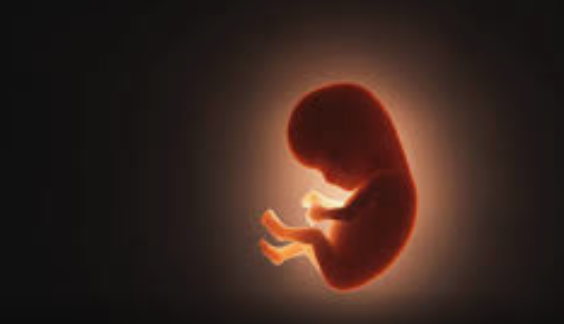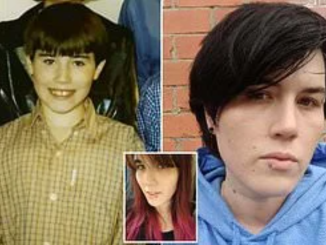
Years ago, two girls in their late teens became pregnant and sought help for their unplanned pregnancies. What they were told was that a chemical abortion was a fast, easy and effective way to end their pregnancies and carry on with their young lives. That lie and the scant information about what they were about to endure, they said, left them unprepared for the emotional and physical trauma that was to follow.
What Krissy Shivey wasn’t warned about was that the amount of blood loss she was going to suffer would turn a bathroom stall into what she described as a “crime scene” after a murder. Soon after she swallowed the second of two abortion pills, also referred to as a “medical” or “medication abortion” she bled out.
Dora Esparza said she found herself blacking in and out of consciousness because the pain from the induced contractions after taking the second pill brought about painful contractions.
In a chemical abortion, women are given two drugs: mifepristone or RU-486, and misoprostol. Mifepristone works by blocking the effects of the natural pregnancy hormone progesterone. Misoprostol induces contractions and a miscarriage.
Both women, Shively from Louisiana and Esparza from Texas, eventually sought healing after their abortions, finding forgiveness through different post-abortive ministries that inspired them to share their testimonies with others who’ve had an abortion or are contemplating one.
The nation’s largest abortion provider, Planned Parenthood, promotes chemical abortions as a “safe and effective” way to end a first-trimester pregnancy. Initially, the Food and Drug Administration only approved the use of these drugs to induce an abortion up to seven weeks into a pregnancy, or 49 days after conception. During the Obama administration, however, the FDA changed its protocol for use up to 60 days.
Sue Turner, director of Physicians for Life, previously told The Christian Post that under pressure, the FDA made this change because abortion providers were already dispensing the drugs up to 60 days, ignoring state law mandating that abortionists follow the FDA’s original protocol.
After the U.S. Supreme Court overturned Roe v. Wade, concluding there is no constitutional right to abortion some groups, like Aid Access in Austria, have been sending abortion pills by mail to Americans across the country. These abortion pills are being mailed without women first consulting with a doctor to discuss health risks and the possible need for a surgical abortion afterward. The longer into a pregnancy a woman is when she takes the abortion pills the less likely they are to be effective at expelling the pregnancy, and the potential need for a surgical abortion increases. Thus, some women are then charged for both a chemical and surgical abortion.
Michael J. New, a researcher and associate scholar at the pro-life Charlotte Lozier Institute, spoke with The Christian Post about the health risks posed to women who have a chemical abortion.
New said as of 2018, the FDA has attributed 24 deaths and over 4,000 adverse events to abortion pills. Due to poor reporting of abortion data in the U.S., however, the pro-life researcher believes the actual numbers are likely higher.
He also noted that a 2015 study that analyzed 50,000 California women whose abortions were covered by Medicaid found the complication rate for chemical abortions was four times higher than for surgical abortions.
A separate study commissioned by the nonprofit group Support After Abortion and Shapard Research released in August surveyed 14,000 women, 114 of whom had a chemical abortion. Of the women who underwent a chemical abortion, 34% said their perception of themselves or their decision was negative following their abortion. Twenty-four percent sought help after their abortion, and an additional 39% didn’t seek help but believed they could benefit from talking with someone.
The two women interviewed by CP who had chemical abortions and later sought healing highlighted the emotional trauma that can result from terminating a pregnancy.
“There is nothing natural or safe about it,” Shivey told CP. “Essentially, you become your own abortionist, and nothing can prepare you for how traumatizing that is. Your safe place, whether it be your home or your workplace, becomes a graveyard. The emotional toll that it takes, the trauma that happens in those places that are supposed to feel safe … You’re robbed of so much more than the life of your child. You’re robbed of your safe place.”
Esparza shared similar sentiments, explaining that an abortion “stays with you forever, regardless of whether it’s chemical or surgical.”
“It’s a permanent decision that you can never quite clean; you can never change it,” she said. “The emotional side of it is life-changing.”
In March 2006, one month before Shivey turned 19, she was sexually assaulted. While she did not become pregnant from the rape, she felt the rape meant she had failed to keep herself pure.
Shivey recalled that the assault caused her to lose her “moral compass,” resulting in her becoming pregnant near the end of April during her second semester of college at Louisiana State University. She did not know the identity of the child’s father.
“When I found out I was pregnant, it was just, I knew it was like the ultimate failure,” Shivey said.
Her father was a retired Air Force Colonel who was well-respected in her church and the local community. Shivey shared with her church that she had been raped, but there were doubts from some about whether she had told the truth.
She already felt devastated, thinking she had failed to keep herself pure, and at the time, aborting the pregnancy seemed like the “lesser of two evils.”
A college friend that Shivey knew through a few shared classes knew about the pregnancy. She was married with two kids, and Shivey confided in her since the friend wasn’t connected to the same church community.
The day after she told her friend that she was pregnant, she gave Shivey a note with the name of a doctor and an appointment time. The doctor worked at a public health unit in Shreveport, Louisiana, and the friend said that he owed her a favor.
“And she said to show up there tomorrow morning, and he’s going to take care of you,” Shivey said.
Over the years, Shivey has reached out to this friend from college, but she has not received a response. After the abortion, Shivey remembers her college friend became “unapproachable.”
The girl was a Christian, and while Shivey believes her friend had wanted to help, a part of her was angry because no one had prepared her for what would happen during and after the abortion.
When she visited the public health unit for the appointment, Shivey was around 10 to 11 weeks pregnant. She recalled that the facility was “cold,” describing it as “dirty and dark.” The clinic provided her with an ultrasound, but Shivey remembered the picture wasn’t clear, and the screen was angled away from her.
“And I remember them saying that she needs to go to Hope, which is the abortion clinic in Shreveport,” she said. “They were whispering among themselves, and the doctor came in and said through whispered tones, ‘No, this is what we’re going to do.’”
The public health unit provided her with the first chemical abortion pill dose, which Shivey took at the clinic. Before leaving, she was handed a bag containing the second pill which she was told to take at home the next day.
“All I remember them saying was that it would be natural, just like a really heavy period,” she said. “And so, I remember thinking, ‘OK, I can handle that.’”
The next day, Shivey took the second pill and went to work at Books-A-Million. She took a few pads with her for the bleeding, noting that she was never told she needed to stay home because she was about to have a miscarriage and would be hemorrhaging.
“I remember the pain when it first kicked in, and I was like, ‘Oh, my God. This hurts. This is not like normal cramping,’” she said.
The “first gush” of blood started as Shivey went to the bathroom, and the amount was so significant that she was forced to remove her pants and hang them over the bathroom stall. She also barricaded the bathroom door with a trash can to prevent her boss or a customer from walking in on her.
“I was freaking out because I didn’t have pants on, and I had locked myself in the bathroom, but I couldn’t stop the bleeding, and I couldn’t clean it up fast enough,” she said.
She does not know how long she bled but looking back on it, the bathroom, she said, resembled a “crime scene” with blood all over the floor. As she struggled to stand, Shivey passed her baby.
“I remember squatting down and looking and seeing her little, tiny arms and legs and her little eyes that you could see,” she said.
In a frantic state of mind, Shivey debated whether to throw her baby’s remains in the trash or flush them down the toilet. After deciding to flush the baby’s remains in the toilet, afraid customers or her coworkers might see it if she threw it in the trash, she got dressed and left work, never returning to the bookstore.
The regret hit her immediately, Shivey recalled. Even though the amount of blood she lost scared her, she decided against going to the hospital and recovered at a friend’s house instead, fearful that her father would find out about the abortion.
“I could feel the void and the emptiness in me where she was and where she was supposed to be,” she said. “And that utter feeling of despair and ‘Oh my God. What did I do?’ And I didn’t even really recognize her as a life until she was gone and that void was there and darkness consumed me.”
Shivey remembers months went by where she just felt herself spiral, laying on the floor sometimes for days at a time and drinking to numb the pain. Two weeks after the abortion, she had her daughter’s name, Mackenzie May, tattooed on her back in Chinese alongside Japanese cherry blossoms, the flower for May, the month she had the induced miscarriage.
Around two months after she had the abortion, Shivey told her parents, who didn’t believe she was telling the truth.
Because he had been overwrought and unusually emotional, it was decided that she should be checked into the psych ward. She was an inpatient for separate times after the abortion. First in September 2006, then October 2006, November 2006 and January 2007. Shivey believes the ward misdiagnosed her as bipolar when her real issue was trauma.
“Every time I got out, I would try to find somebody else to tell about the abortion, my baby, the rape,” she said. “And then I would go back to my parents, and they would say, ‘Oh, she’s spewing lies again.’”
Shivey’s parents sent her to live with a pastor in February 2007 who ran a discipleship program in Baton Rouge, about four hours away from her hometown of Shreveport. Her parents believed that she had made the story up because she was mentally ill.
It wasn’t until October 2020, when Shivey was able to recall more details about the experience, that her parents believed her story. She now has a “wonderful” relationship with her parents and they, too, have found closure from the past and have been supportive of her journey toward healing.
After moving to southern Louisiana, Shivey remembered how God did what she described as “amazing work” for her. In 2009, Shivey married her husband, having met him through a church that no longer exists. Their first daughter was born in January 2010, and she eventually gave birth to her youngest daughter in March 2016 after losing three children to miscarriages in between.
*snip*
“So, I wanted accountability because I knew that the fear could push me to do it,” she said. “My friends promised they would help me through it and that they would help me choose life and encourage me.”
She then called her boyfriend, the baby’s father, who came over just as Esparza’s friends were leaving. After telling him about the pregnancy, Esparza started asking him how he wanted to tell each of their parents, and he responded by reminding her that there were other options.
by myself in the bathroom, and they don’t tell you that.”
Planned Parenthood did tell her not to look in the toilet, but she did anyway. She described that there was blood all over it and on the floor. As soon as she could tolerate the pain, she started cleaning everything up, still feeling embarrassed and not wanting anyone to see it.
Her boyfriend later helped her to bed, and she said that she slept for the whole day. Even before taking the pills, Esparza was suffering from depression, and she began smoking and drinking a lot to try to mask the pain.
Two weeks later, she returned to Planned Parenthood for a follow-up appointment. The nurses told her that there were still parts of her baby left inside her and they would have to perform an emergency D&C.
After taking her back to the consultation room, the staff gave her anxiety and pain medications as they started explaining the procedure. Esparza didn’t pay much attention, as she was distracted by the sound of women screaming down the halls.
“I started hyperventilating at that point, and the nurse gave me an extra dose of anxiety and pain medications,” she said. “I was really drugged at that point, very numb to everything but still aware of what was going on.”
Esparza said a staff person then escorted her into an unsanitary procedure room where she saw blood-stained instruments and fetal tissue left from an abortion that had been performed before her. A nurse was agitated and angry that Esparza had noticed and asked about the dirty tools and ordered staff to take her to a different room.
“I didn’t find out until years later that was unethical. I could have filed a lawsuit, but I didn’t know my rights at that point,” she said.
Even with the pain medication, Esparza recalled that the surgical abortion was painful.
“But the hardest part for me was just laying there, thinking that my baby was a fighter and he was trying his best to survive,” she said. “After the procedure, I called my boyfriend, and he and his roommate came. His roommate drove my car back to his house, and my boyfriend drove me.”
“We didn’t talk at all in the car. I was just crying the whole time.”
For the next six or seven months, Esparza fell into a state of depression where she stopped eating and caring about hygiene. She remembered how she would just smoke all day and get high until she blacked out, and during this time, she began to contemplate suicide.
As she started writing letters to her loved ones, she found that she could not go through with killing herself once she started writing a letter to her mother.
“I remember thinking of all the pain that I was going through for having lost a child and then inflicting that pain on my mom. I couldn’t go through with it because of that,” Esparza said.
“And I still have that letter I wrote to my mom in one of my memory boxes. But soon after that, I just slowly started getting back on my feet.”
Six months after the abortion, Esparza’s mother noticed she had lost weight and inquired about what was going on with her. Esparza began crying and told her the truth, and her mother held her and cried with her.
A few days before Esparza’s birthday on March 1, she and her boyfriend broke up after he cheated on her. He told her via text that their relationship was over.
“It was just a bad ending, and I came to the realization of what I had done for someone who wasn’t even worth it,” she said.
Three years later, Esparza was still smoking daily, becoming a functional “pothead” and alcoholic. Throughout her early 20s, she spent most of her time going to bars and behaving in a promiscuous manner.
“It was during this time that I started feeling this sense of the Lord knocking on the door of my heart,” she said. “I had grown up Catholic, so I knew who Jesus was, but He was never a personal Savior to me.”
“I was just asking the Lord to help me live right. To help me surrender to Him because I didn’t want to.”
After giving her life to the Lord, Esparza began dressing differently and stopped engaging in premarital sex, eventually meeting her husband in June 2015 and marrying him three months later. The pair met through Facebook, and both were at a place in their lives where they desired to walk with the Lord and get married.
The couple married after praying and fasting with one another to see if it was the right choice and listened to see if it was God’s will. After marrying, they had two sons, one born on July 12, 2016, and the second on Jan. 22, 2018.
In August 2019, Esparza attended a post-abortive retreat through Rachel’s Vineyard, a healing ministry that helps men and women recover after an abortion. The retreat provides an environment for participants to begin healing through Scripture reading, prayer and various exercises to help them process their emotions.
She attended the retreat after coming across Silent No More, an organization that reaches out to women hurt by abortion and encourages healing. Esparza wanted to work for them as a regional coordinator, and attending a Rachel’s Vineyard retreat or a post-abortive Bible study was a requirement for assuming the role.
“I had this attitude of, ‘I’m in Christ, and I’ve been forgiven. I don’t know how this is going to help,’” she said. “But I was very wrong, and the Lord humbled me quickly.”
After going through the retreat, Esparza felt she was able to separate the life of her first child from the abortion. She still has the sonogram that Planned Parenthood gave her, and it now sits on the wall along with the rest of their family pictures.
Dora Esparza’s sonogram from Planned Parenthood. | Courtesy of Dora Esparza
The Lord also compelled Esparza to share her testimony after attending the retreat. Since then, she has traveled to multiple states to share her testimony and spoken on the radio and podcasts to help men and women see abortion is not as easy as society would have them believe.
As she began to publicly share her story, Esparza decided to tell her father about the abortion, and she believes she told her brother around the same time. Both have been supportive of her since finding out the truth.
One of her mentors through Silent No More introduced her to the directors of A Woman’s Haven, a pregnancy resource center in San Antonio. In 2020, Esparza started working for them as a speaker at their events. About a year ago, she began working as a counselor for them, and two months ago, they promoted her to supervisor.
She does post-abortive counseling for the clinic and has met with many different types of women, including those who became pregnant after an initial abortion and others who are looking to heal.
“Whether people want to believe it or not, there is a silent majority that is hurting and not sharing because it’s too painful,” Esparza said. “And so, emotionally speaking, it just changes the core of who you are.”
* Article from: The Christian Post


